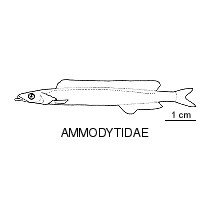- Classification
- ACTINOPTERYGII
- PERCIFORMES
- AMMODYTIDAE
-
Fish Classification
-
Class
ACTINOPTERYGII Ray-finned fishes -
Order
PERCIFORMES Perches and allies -
Family
AMMODYTIDAE Sandlances
Family AMMODYTIDAE
Common name: Sandlances
Summary:
Sandlances occur worldwide in temperate regions of the Arctic, Atlantic, Indian, and Pacific oceans, mostly inhabiting shallow coastal waters, although one species occurs on the upper continental slope. They feed in aggregations on zooplankton over open sandy bottoms, diving into the sand for shelter. They are distinctive in having an elongate body, a protrusible premaxilla, small cycloid scales partly fused to form oblique scale rows, no fin spines, a long-based dorsal fin, a short-based anal fin, and usually no pelvic fins. Maximum size is 40 cm in length.
Cite this page as:
Dianne J. Bray, Sandlances, AMMODYTIDAE in Fishes of Australia, accessed 30 Jun 2025, https://fishesofaustralia.net.au/home/family/89
More Info
|
Family Taxonomy |
The Australian fauna includes three species in two genera. |
|
Family Biology |
Collette, B.B. 2001. Ammodytidae. 3518 in Carpenter, K.E. & Niem, T.H. (eds). The Living Marine Resources of the Western Central Pacific. FAO Species Identification Guide for Fisheries Purposes. Rome : FAO Vol. 6 pp. 3381-4218. Ida, H., Sirimontaporn, P. & Monkolprasit, S. 1994. Comparative morphology of the fishes of the family Ammodytidae, with a description of two new genera and two new species. Zoological Studies 33(4): 251-277 figs 1-14 Randall, J.E.& Heemstra, P.C. 2008. Ammodytoides xanthops, a new species of sandlance (Perciformes: Ammodytidae) from Mozambique. Smithiana, Publications in Aquatic Biodiversity, Bulletin 9: 21-25. Randall, J.E. & Ida, H. 2014. Three new species of sand lances (Perciformes: Ammodytidae) from the southwest Indian Ocean. Journal of the Ocean Science Foundation 12: 1-11. |
|
Author |
Dianne J. Bray |









